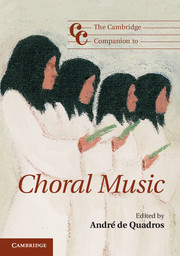Book contents
- Frontmatter
- 1 Introduction: choral music – a dynamic global genre
- Part I Choral music: history and context
- Part II Choral music the world over
- 6 Choral music and tradition in Europe and Israel
- 7 Canada's choral landscape
- 8 A multiplicity of voices: choral music in the United States
- 9 A hundred years of choral music in Latin America 1908–2008
- 10 Choral music in East Asia: China, Japan, and Korea
- 11 New voices in ancient lands: choral music in South and Southeast Asia
- 12 From chanting the Quran to singing oratorio: choral music in West and Central Asia
- 13 Voices of the Pacific: the (ch)oral traditions of Oceania
- 14 Choral music in Africa: history, content, and performance practice
- Part III Choral philosophy, practice, and pedagogy
- Notes
- Select bibliography
- Index
- Cambridge Companions to Music
12 - From chanting the Quran to singing oratorio: choral music in West and Central Asia
from Part II - Choral music the world over
Published online by Cambridge University Press: 28 September 2012
- Frontmatter
- 1 Introduction: choral music – a dynamic global genre
- Part I Choral music: history and context
- Part II Choral music the world over
- 6 Choral music and tradition in Europe and Israel
- 7 Canada's choral landscape
- 8 A multiplicity of voices: choral music in the United States
- 9 A hundred years of choral music in Latin America 1908–2008
- 10 Choral music in East Asia: China, Japan, and Korea
- 11 New voices in ancient lands: choral music in South and Southeast Asia
- 12 From chanting the Quran to singing oratorio: choral music in West and Central Asia
- 13 Voices of the Pacific: the (ch)oral traditions of Oceania
- 14 Choral music in Africa: history, content, and performance practice
- Part III Choral philosophy, practice, and pedagogy
- Notes
- Select bibliography
- Index
- Cambridge Companions to Music
Summary
Historically, West and Central Asia has been considered a region with a less developed choral music tradition. This lack of choral development had many causes, such as limitations put on music activities by Islam, the main religion for the Arab, Persian, and Turkic ethnic groups predominantly living in this part of the world; focus on individual rather than collective musical self-expression; the prevalence of monodic forms; improvisation as the key element of the music. Nonetheless, it would be simplistic to ignore unique forms of choral music that have emerged in this region since antiquity. These forms have later become sources for creative exploration by national composers. Arab, Persian and Turkic music traditions are distinct from each other and diverse within themselves. However, they underwent long historical periods of convergence and mutual influence which caused the presence of many common traits.
The earliest forms of choral music in the region go back to Zoroastrianism, the oldest of the revealed religions, which emerged in Iran and later spread out to the subcontinent, including territories of the present-day Azerbaijan, Uzbekistan, and Tajikistan. Zoroastrianism considered music as a sacred channel, a means of communication between human beings and the divine. In combination with the idea of collectivism essential for this faith, this belief was responsible for the important role of choral singing in Zoroastrian rituals. Prophet Zoroaster is believed to be the author of gathas, the hymns of praise that date to the second millennium BCE and have been included in Avesta, the holy book of faith. Seventeen gathas are a part of yasna, Zoroastrian liturgy, being arranged according to meter in five groups.
- Type
- Chapter
- Information
- The Cambridge Companion to Choral Music , pp. 169 - 176Publisher: Cambridge University PressPrint publication year: 2012

